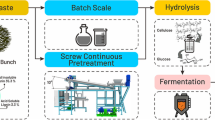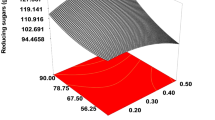Abstract
A statistical based study employing response surface method (RSM) was conducted to ascertain the optimum pretreatment conditions using an alkaline wash technique i.e. at different temperature, time and base concentration using Malaysian oil palm empty fruit bunches (EFB) as a model substrate. Strong acid-dilute acid hydrolysis and dietary fibre methods were used in order to determine structural carbohydrates and lignin content of pretreated EFB and analysed using one-way analysis of variance (ANOVA). Based on the RSM model, 17 runs of different pretreatment conditions were carried out. ANOVA analysis on the different techniques yielded an F value of 5.32 leading to the rejection of null hypothesis. As such, both techniques were determined to be statistically different. Response surface model with quadratic function was generated for biomass pretreatment using alkaline wash which has indicated that sodium hydroxide concentration is the most important factor in determining lignin removal, followed by time of reaction. The final lignin content of pretreated biomass shall be 9.04 wt.% which is 62.7% of lignin removal.



Similar content being viewed by others
References
Fernando S, Adhikari S, Chandrapal C, Murali N (2006) Biorefineries: current status, challenges and future direction. Energy Fuel 20:1727–1737
Garcia-Nunez JA, Ramirez-Contreras NE, Rodriguez DT, Silva-Lora E, Frear CS, Stockle C, Garcia-Perez M (2016) Evolution of palm oil mills into bio-refineries: literature review on current and potential use of residual biomass and effluents. Resour Conser Recycling 110:99–114
Esposito D, Antonietti M (2015) Redefining biorefinery: the search for unconventional building blocks. Chem Soc Rev 44:5821–5835
Kumar P, Barrett DM, Delwiche MJ, Stroeve P (2009) Methods for lignocellulosic biomass for efficient hydrolysis and biofuel production. Ind Eng Chem Res 48:3713–3729
Awalludin MF, Sulaiman O, Hashim R, Wan Nadhari WNA (2015) An overview of the oil palm industry in Malaysia and its waste utilization through thermochemical conversion, specifically via liquefaction. Renew Sus Energy Rev 50:1469–1484
Abnisa F, Daud WMAW, Husin W, Sahu JN (2011) Utilization possibilities of palm shell as a source of biomass energy in Malaysia by producing bio-oil in pyrolysis process. Biomass Bioenergy 35:1863–1872
Goh CS, Tan KT, Lee KT (2010) Bio-ethanol from lignocellulose: status, perspective and challenges in Malaysia. Bioresour. Tech. 101:4834–4841
Karim RA, Hussain AS, Zain AM (2014) Production of bioethanol from empty fruit bunches cellulosic biomass and Avicel PH-101 cellulose. Biomass Conv Bioref 4:333–340
Katahira R, Mittal A, McKinney K, Chen X, Tucker MP, Johnson DK, Beckham GT (2016) Base catalysed depolymerisation of biorefinery lignin. ACS Sustainable Chem & Eng 4:1474–1486
Roberts VM, Stein V, Reiner T, Lemonidou A, Li X, Lercher JA (2011) Towards quantitative catalytic lignin depolymerisation. Chem Eur Jour 17:5939–5948
Dabral S, Mottweiler J, Rinesch T, Bolm C (2015) Base-catalysed cleavage of lignin β-O-4 model compounds in dimethyl carbonate. Green Chem 17:4908–4912
Xu C, Arancon RAD, Labidi J, Luque R (2014) Lignin: depolymerisation strategies: towards valuable chemicals and fuels. Chem Soc Rev 43(22):7485–7500
Wang H, Tucker M, Ji Y (2013) Recent development in chemical depolymerisation of lignin: a review. Jour Appl Chem. doi:10.1155/2013/838645
ASTM International, ASTM E1690 Standard method for determination of ethanol extractives in biomass (2016)
Goering HK and PJ Van Soest (1970) Forage fiber analysis (apparatus, reagents, procedures, and some applications). Agricultural Research Service (ARS) Handbook. No. 379. Washington, DC
Van Soest PJ, Robertson JB, Lewis BA (1991) Methods for dietary fiber, neutral detergent fiber, and non-starch polysaccharides in relation to animal nutrition. J Dairy Sci 74:3583–3597
Chaves AV, Waghorn GC, Tavendale MH (2002) A simplified method for lignin measurement in a range of forage species. Proceedings of the New Zealand Grassland Association 64:129–133
Sluiter, A. Ruiz, R., Scarlata, C., Sluiter, J., D. Templeton and D. Crocker (2008) Determination of structural carbohydrates and lignin in biomass. Colorado: National Renewable Energy Laboratory. Laboratory Analytical Procedure. NREL/TP-510-42618
Medina JDC, Woiciechowski A, Filho AZ, Noseda MD, Kaur BS, Soccol CR (2015) Lignin preparation from oil palm empty fruit bunches by sequential acid/alkaline treatment—a biorefinery approach. Bioresour. Tech. 194:172–178
Chiesa S, Gnansounou E (2014) Use of empty fruit bunches from the oil palm for bioethanol production: a thorough comparison between dilute acid and dilute alkali pretreatment. Bioresour Tech 159:355–364
Nieves DC, Karimi K, Horvath IS (2011) Improvement of biogas production from oil palm empty fruit bunches (OPEFB). Ind Crops Prods 34:1097–1101
Isroi, Mofoluwake MI, Ria M, Siti S, Muhammad NC, Claes N, Taherzadeh MJ (2012) Structural changes of oil palm empty fruit bunch (OPEFB) after fungal and phosphoric acid pretreatment. Molecules 17:14995–15012
Abdullah N, Sulaiman F, Gerhauser H (2011) Characterisation of oil palm empty fruit bunches for fuel application. Jour Phy Sci 20:1–24
Financie R, Moniruzzaman M, Uemura Y (2016) Enhanced enzymatic delignification of oil palm biomass with ionic liquid pretreatment. BioChem Eng Jour 110:1–7
Abdul PM, Jahim JM, Harun S, Markom M, Lutpi NA, Hassan O, Balan V, Dale BE, Mohd. Nor MT (2016) Effects of changes in chemical and structural characteristic of ammonia fibre expansion (AFEX) pretreated oil palm empty fruit bunch fibre on enzymatic saccharification and fermentability for biohydrogen. Bioresource Tech 211:200–208
Taherzadeh MI, Karimi K (2008) Pretreatment of lignocellulosic wastes to improve ethanol and biogas production: a review. Intl Jour Mol Sci 9:1621–1651
Mirahmadi K, Kabir MM, Jeihanipour A, Karimi K, Taherzadeh MJ (2010) Alkaline pretreatment of spruce and birch to improve bioethanol and biogas production. Bioresources 5(2):928–938
Myers RH, Montomery DC (2009) Response surface methodology: process and product optimization using designed experiments, 3rd edn. Wiley, New York, pp 317–321
Khuri AI, Mukhopadhyay S (2010) Response surface methodology. WIREs Computational Statistics:128–149
Bas D, Boyaci IH (2007) Modelling and optimization I: usability of response surface methodology. J Food Eng 78(3):836–845
Bezerra MA, Santelli RE, Oliveira EP, Villar LS, Escaleira LA (2008) Response surface methodology (RSM) as a tool for optimization in analytical chemistry. Talanta 76:965–977
Whitcomb, P. J., Larntz, K., (1992) The role of pure error on normal probability plots, presented at Transactions of the 46th Annual Quality Congress, Milwaukee
Akhtar J, Teo CL, Lai LW, Hassan N, Idris A, Aziz RA (2015) Factors affecting delignification of oil palm empty fruit bunch by microwave-assisted dilute acid/alkali pretreatment. Bioresources 10(1):588–596
Muryanto, Eka T, Haznan A, Agung. C, Effendi TC, Yanni S (2015) Alkaline delignification of oil palm empty fruit bunch using black liquor from pretreatment. Procedia Chemistry 16:99–105
Hong JY, Kim YS, Oh KK (2013) Fractionation and delignification of empty fruit bunches with low reaction severity for high sugar recovery. Bioresour Technol 146:176–183
Choi, W. I., Park, J. Y., Lee, J. P., Oh, Y. K., Park, Y. C., Kim, J. S., Park, J. M., Kim, C. H., Lee, J. S. (2013) Optimization of NaOH-catalyzed steam pretreatment of empty fruit bunch, Biotechnology for Biofuels, 6 (170)
Hamisan AF, Aziz SA, Kamaruddin K, Md Shah UK, Shahab N, Hassan MA (2009) Delignification of oil palm empty fruit bunch using chemical and microbial pretreatment methods. Int J of Agricultural Research 4(8):250–256
Acknowledgements
The authors would like to acknowledge PETRONAS and PETRONAS Chemical Group Bhd. (PCGB) for funding this work.
Author information
Authors and Affiliations
Corresponding author
Rights and permissions
About this article
Cite this article
Zawawi, A., Gaik, L.P., Sebran, N.H. et al. An optimisation study on biomass delignification process using alkaline wash. Biomass Conv. Bioref. 8, 59–68 (2018). https://doi.org/10.1007/s13399-017-0246-x
Received:
Revised:
Accepted:
Published:
Issue Date:
DOI: https://doi.org/10.1007/s13399-017-0246-x




